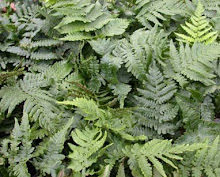
Saturday, June 6, 2009
Wednesday, May 27, 2009
Goldie's Wood Fern

Dryopteris goldiana
Dryopteridaceae
Goldie's Wood Fern is rare in Connecticut; it is listed as a species of special concern. This is the largest of the native wood ferns, reaching 4’ under ideal conditions. It is a stately and slowly spreading groundcover, forming large clusters of graceful arching fronds. Named for Scottish botanist John Goldie, its fronds are green without a hint of gold.
Dryopteridaceae
Goldie's Wood Fern is rare in Connecticut; it is listed as a species of special concern. This is the largest of the native wood ferns, reaching 4’ under ideal conditions. It is a stately and slowly spreading groundcover, forming large clusters of graceful arching fronds. Named for Scottish botanist John Goldie, its fronds are green without a hint of gold.
Royal Fern

Osmunda regalis
Osmundaceae
This gracefully cascading fern is beautiful in all stages of growth. In proper conditions, Osmunda regalis forms a three-foot, vase-shaped clump. The young unfurling fiddleheads begin chartreuse in color then turn a rich emerald green as the season progresses. Fertile spores form attractive panicles of rich cinnamon brown. The Royal Fern prefers damp conditions and rich organic soils. This fern can even be grown in full sun if planted near water.
Osmundaceae
This gracefully cascading fern is beautiful in all stages of growth. In proper conditions, Osmunda regalis forms a three-foot, vase-shaped clump. The young unfurling fiddleheads begin chartreuse in color then turn a rich emerald green as the season progresses. Fertile spores form attractive panicles of rich cinnamon brown. The Royal Fern prefers damp conditions and rich organic soils. This fern can even be grown in full sun if planted near water.
Oak Fern
Marsh Fern

Thelypteris palustris
Thelypteridaceae
This is a very common fern in wet, sunny areas. It can be found inhabiting the moist edges of wetland areas. Fertile fronds, 18-24 inches in height, have leaf edges that are slightly rolled over the spore-bearing sori. These rolled edges distinguish the Marsh Fern from its relative Massachusetts Fern.
Thelypteridaceae
This is a very common fern in wet, sunny areas. It can be found inhabiting the moist edges of wetland areas. Fertile fronds, 18-24 inches in height, have leaf edges that are slightly rolled over the spore-bearing sori. These rolled edges distinguish the Marsh Fern from its relative Massachusetts Fern.
Maidenhair Fern

Adiantum pedatum
Pteridaceae
Just 18 inches tall, the Maidenhair Fern is the daintiest of all native ferns. The graceful fan-like fronds have wiry black stems, which wave in the wind. It does best in filtered light and well-drained, cool soil. Adequate moisture is needed to keep the frilly fronds in perfect shape during the growing season. This fern spreads fairly slowly by branching rhizomes and forms large colonies. Its delicate texture looks most beautiful when paired with broad leaf plants in the garden.
Pteridaceae
Just 18 inches tall, the Maidenhair Fern is the daintiest of all native ferns. The graceful fan-like fronds have wiry black stems, which wave in the wind. It does best in filtered light and well-drained, cool soil. Adequate moisture is needed to keep the frilly fronds in perfect shape during the growing season. This fern spreads fairly slowly by branching rhizomes and forms large colonies. Its delicate texture looks most beautiful when paired with broad leaf plants in the garden.
Long Beech Fern
Lady Fern

Athyrium filix-femina
Dryopteridaceae
This Lady Fern is fine and delicate in appearance, yet so hardy and tolerant. The lacy three-foot fronds of this sophisticated species unfurl celery green in full or partial shade then turn darker as the season progresses. The fronds are long, tapering, and beautifully symmetrical, with a delicate look that belies their tough-as-nails constitution and reliability. The lacy architectural fronds make superb additions to any border, bed, or even containers. The Lady Fern is easy to grow, making this a good fern for beginners. It does best in shady conditions with moist soil.
Dryopteridaceae
This Lady Fern is fine and delicate in appearance, yet so hardy and tolerant. The lacy three-foot fronds of this sophisticated species unfurl celery green in full or partial shade then turn darker as the season progresses. The fronds are long, tapering, and beautifully symmetrical, with a delicate look that belies their tough-as-nails constitution and reliability. The lacy architectural fronds make superb additions to any border, bed, or even containers. The Lady Fern is easy to grow, making this a good fern for beginners. It does best in shady conditions with moist soil.
Bulbet Fern

Cystopteris bulbifera
Dryopteridaceae
Bulblet fern fronds are long and narrow, tapering very gradually to the tip. They inhabit shaded limestone-rich cliffs & outcroppings. Bulblet Fern gets its name from the green bulblets that form on the underside of the leaves. The bulblets drop off and grow into new ferns which will mature to 12-30 inches in height.
Dryopteridaceae
Bulblet fern fronds are long and narrow, tapering very gradually to the tip. They inhabit shaded limestone-rich cliffs & outcroppings. Bulblet Fern gets its name from the green bulblets that form on the underside of the leaves. The bulblets drop off and grow into new ferns which will mature to 12-30 inches in height.
Subscribe to:
Posts (Atom)




